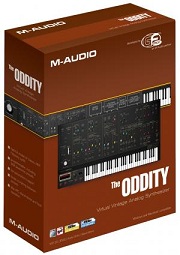![]()
MATTHIAS: The Prodyssey really fills a gap between Minimax and Pro One, that's why we created it. It's capable of all those experimental sounds one might miss with the Minimax or the Pro One. And I think our synths sound a lot better than the plug-ins from the VST side. Listening to our synths is like you have taken the red pill, you just cannot go back anymore. The DSP modules weren't just taken from the shelf. When you compare our device to the Oddity simply go for some FM on the oscillators and on the filter with high resonance, do this by using the S&H mixer with noise, and you'll hear the difference. The Odyssey oscillators first sound boring since they only have saw and pulse waves, but there are some specialities. The pulse width for example is only adjustable from 50% to 95% and if you modulate it with the LFO you'll hear that it stays in these limits, being full wave rectified at the 50% limit. This makes it also quite unique and adds especially to PWM pads a certain flavour you won't get on other synths. Not to forget the ring modulation of this synth, which I love so much. Actually the ring modulation, even in the analog original, is done digitally. Only the pulse waves are ring modulated and they took a simple comparator which delivers an on/off-signal as a waveform. And guess what, it has awful aliasing, but somehow it contributes beautifully to the whole sound! The noise part of the two synths is also very special.
![]()
Our Prodyssey has some modifications for the reason of polyphony, which I think is an important point. The duo-phonic mode by splitting the oscillators had to be left out, the drone mode is no longer available and the repeat mode had to be modified for that reason. Some might say the original modes were essential, I prefer to have polyphony. I mean we are keyboardists, right? If I wanted to play monophonically only, I could have stuck with my flute lessons in the kindergarten. We also think that some of the really nerdish stuff shouldn't be rebuilt, like the LFO not restarting after the fourth note, it simply makes no sense with polyphony. But all other aspects are modeled to the greatest detail.
We measured the modulation depth on the original to replicate this in the Prodyssey, but on the Prodyssey it is adjustable (see lower left corner on the second page of the device).
![]()
The Oddity seems to be an accurate sample-based model. But there still exist models that are more accurate, just like ours and analog synthesizers. I think this really comes to account with the modulations. Although that I cannot say what exactly happens, I have the feeling that this comes from aliasing in the modulation path.
The Oddity simply sounds blurred with these modulations, which certainly comes from slower calculation or in other words less accuracy of their algorithm. That's the point where you really need to compare. And if it feels right, it is right! And this feeling does not come from features like not restarting something after the fourth note. We update more often and therefore have a more defined modulation.
When you compare our device to the Oddity simply go for some FM on the oscillators and on the filter with high resonance, do this by using the S&H mixer with noise, and you'll hear the difference. By the way, we already had a prototype when the Oddity came out and Prodyssey really fits well into the Noah concept, so we saw no reason to stop.

![]()
The basic quality of the oscillators and the filter of the original Pro One and Odyssey is indeed similar. But there are so many differences, it's hard to name them all. I'll try though. Simply try the oscillators in direct comparison. When you switch through the combinations of Pro One the levels change. This makes the Pro One oscillators pretty unique and does also affect the modulation possibilities of this synth. Not to forget the filter is also driven differently through this. Every Pro One I got hands on had a quite whimsical noise, but when mixed with the triangle only it sounded just like it should. The noise from the Odyssey sounds great. Very distorted, very unique! The modulation part of both synths is also very different. Meanwhile I prefer the one from Odyssey because you can do really weird things with the sample&hold section. Try out sending the S&H mix to OSC 2 or the filter at high resonance and you know what I mean. Now you really see I could go on for ever with this. But what they both have in common is the high quality algorithms which really bring you the sonic possibilities of true analog gear. And that's where after all these years of dull sounding synths you can re-discover new territories!
|
Matthias Klag July 2003 |
|